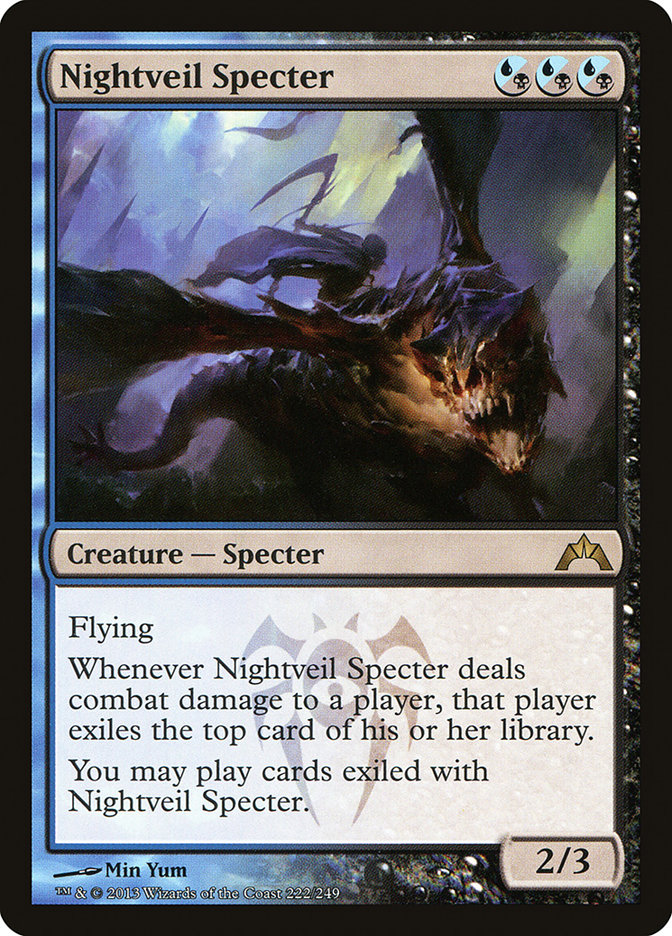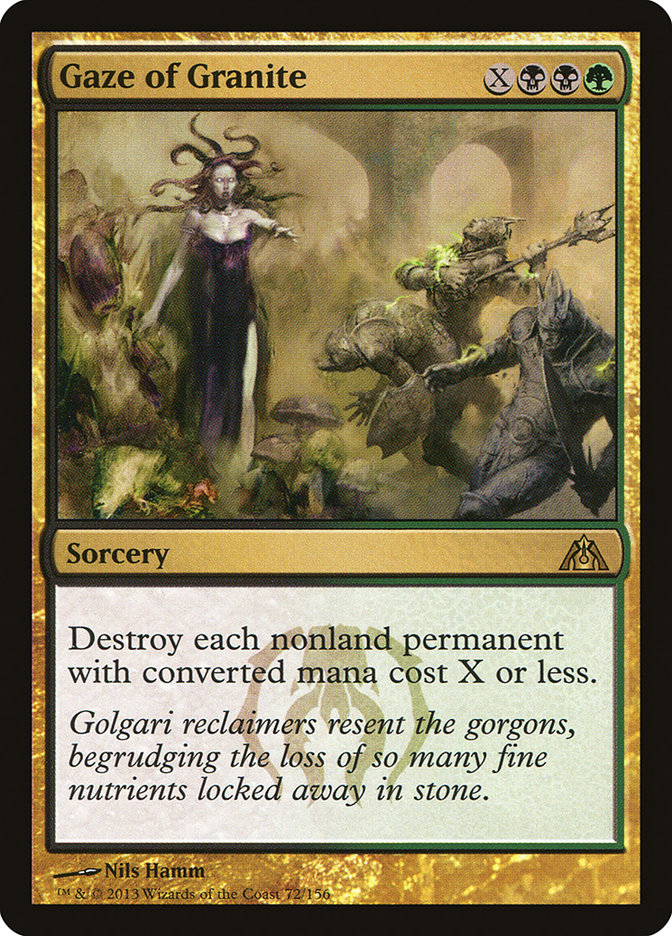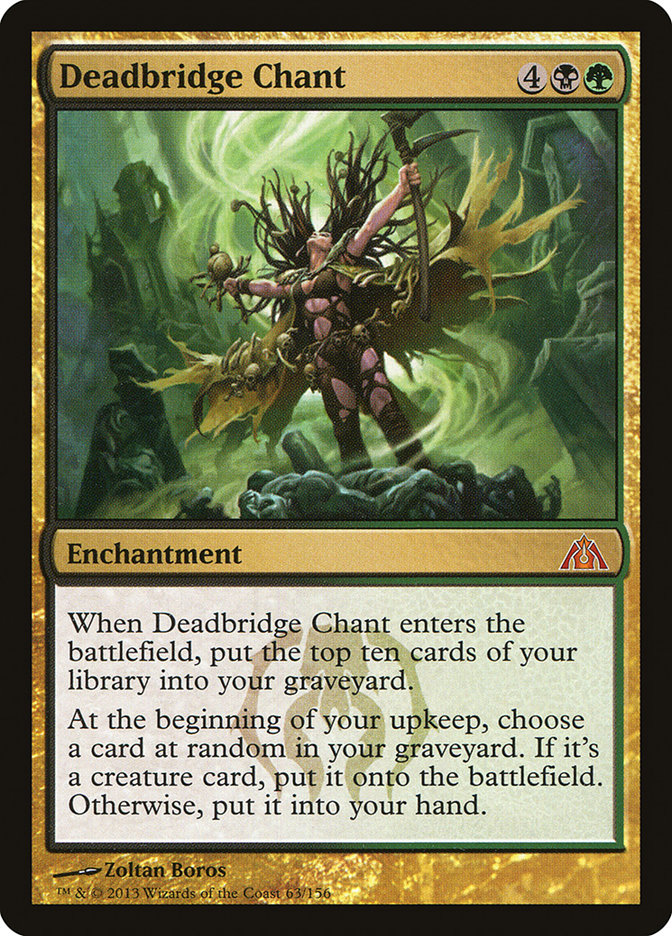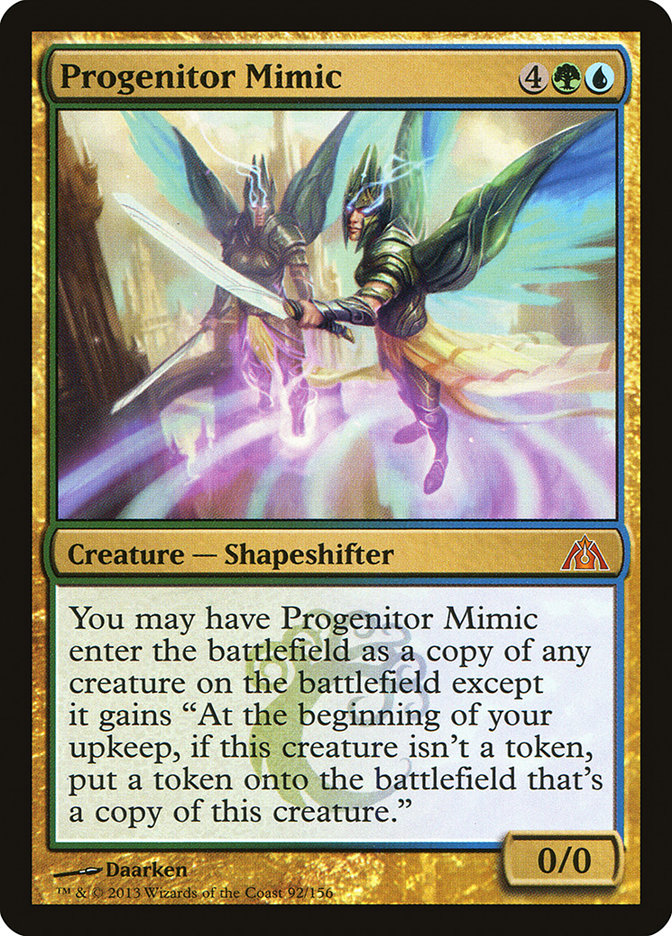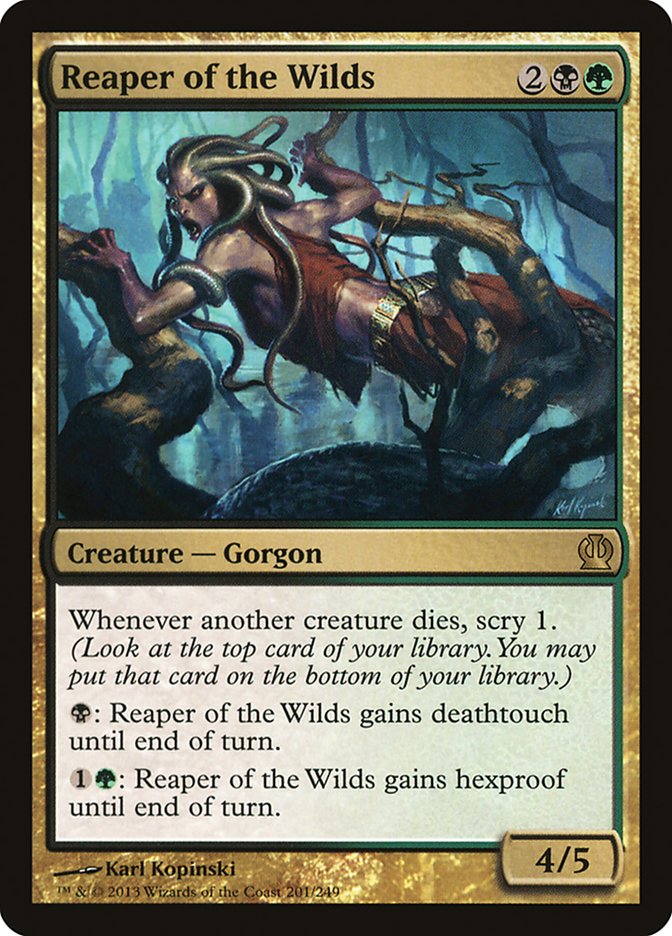It was the best, it was the worst.
This is a tale of two different decks that I’ve been playing in Standard. This last month has been a lot of Magic for me. I started the month of October at SCG Open Series: Cleveland doing commentary, played the next weekend in SCG Open Series: Milwaukee (getting fourth in Standard), followed up with Grand Prix Louisville (47th out of 1048), covered the SCG Invitational with Joey Pasco and Riki Hayashi in Indianapolis, and started November with another tournament in Columbus (winning the 5K event).
I’m a bit exhausted.
Hell, there is a PTQ in nearby Chicago this weekend, and I’m partly thinking about not going to it (heresy!) but know that I’ll end up going in the end. In a big way, I’m grateful that it is going to be a break from Constructed, but if I’m being honest with myself, I know I’m more disappointed if only because I have two incredibly good decks.
BUG Midrange
A lot of people have been asking me for this deck since my finish with it at Grand Prix Louisville. But first here’s a little bit of the story of how the deck came about.
I am a big fan of keeping an open mind when it comes to deckbuilding. This is a philosophy that I take into this realm in two ways. First of all, I am open to individual cards and how they could be useful. Secondly, I am open to ideas from other people even if they might not seem like they are perfect from the get go.
This deck was a direct descendent of the BW deck that I gave to my friend Jonathan Brostoff for #SCGMKE. I talked a little bit about some of the genesis of that deck a few weeks ago, but I’ll go into a little more of it here.
My friend Collin LaFleur is a former Madison resident who recently moved up to the Northwest. Many years ago he won the Wisconsin State Championship with Merfolk and basically announced his existence to the local scene. He sent me a B/W Midrange list that was really intriguing to me, mostly because of the choice in the deck to run Hallowed Fountain as a part of its white sources so that it could use the Plains / Island to be able to cast Nightveil Specter.
I thought that this was a pretty brilliant idea and locked it away into my brain. In my mind, Nightveil Specter was the reason to play the deck, and I’d had enough successes with the card in prepping for Block Constructed that I knew that it was a real player if only it found the right home. I worked on the deck a little bit and passed it on to my friend Jonathan Brostoff the weekend I was doing the coverage of #SCGCLE, and he got second place with it at one of the many State Championships that were held this year.
Jonathan didn’t care for the sneaky elements of the deck that I loved. He definitely made the deck a little more conservative than I might have, but he liked how it played out and sleeved it up again for #SCGMKE. I stayed at his place for that event, and while I wasn’t able to convince him to include the blue mana, I did get him to make a few changes.
Here is what Jonathan played in Milwaukee:
Creatures (18)
- 3 Desecration Demon
- 2 Obzedat, Ghost Council
- 4 Nightveil Specter
- 1 Alms Beast
- 4 Blood Baron of Vizkopa
- 1 Lifebane Zombie
- 3 Gray Merchant of Asphodel
Planeswalkers (2)
Lands (21)
Spells (19)

Jonathan got pretty close to making the Top 8 but ended up losing game 3 of his win-and-in versus G/R Devotion. There are only about fifteen seconds of footage of him playing that deck on camera, but a full match was captured versus Andrew Tenjum with Esper Control.
There was a lot that I liked about how this deck worked, but I loved the idea Collin had had about using the off-color dual lands to be able to splash in the non Nightveil Specter color. Looking at color combinations that could support the Specter, I was excited to realize something:
I could make a BUG deck!
I knew that I wanted to take a look at the Yamamoto deck from Pro Tour Theros as a baseline for the deck, and pretty quickly I was using several elements from that deck as well. I already knew that Yamamoto’s deck was a reasonable deck but couldn’t believe that he was running Lifebane Zombie instead of Nightveil Specter. Nightveil Specter is already an incredibly good card, but especially with Gray Merchant of Asphodel there just seemed like a lot of reasons to have gone the other direction. Mutavault is a reasonable reason to head the other way, but it still looked to me like there were enough sources to support Specter.
At this point I knew I’d have these cards:
Pack Rat
Nightveil Specter
Desecration Demon
Gray Merchant of Asphodel
Whip of Erebos
black removal
The question became “what other cards do I gain access to?” If B/W gave access to Blood Baron of Vizkopa and Obzedat, Ghost Council among others, what would green give? I quickly found Abrupt Decay, but then I found this:
This was pretty darn exciting. I was in that minority of players who had not been excited about the Underworld Connections (perhaps because I’d playtested against so much red or other aggressive decks).
In the end, I had 59 cards that I loved. I tried many different cards for that 60th card before settling on a Lifebane Zombie that I wasn’t all that excited about. Putting all of the pieces together, this is what I registered for Grand Prix Louisville:
Creatures (15)
Planeswalkers (2)
Lands (25)
Spells (18)
Sideboard

There are some spicy ones in this 75. Aside from the Golgari cards I’ve already mentioned, a very large number of players were excited to see Progenitor Mimic hit play. I think of Progenitor Mimic as one of the “Brian Kowal specials,” a card that he had made impressive use of in a few different brews he’d made in Standard when the card was first printed.
During that weekend and since, many players have come up to me to ask me about any number of other green cards I could include in the deck. The most common card named was Sylvan Caryatid, though many people have named Reaper of the Wilds. I actually think Reaper of the Wilds is a reasonable card to consider because it is of a sufficiently high power level. On the other hand, a card like Sylvan Caryatid, Dreg Mangler, or Scavenging Ooze just doesn’t make any sense to me. A part of the reason you want to play this deck is the stability of the black mana. In order to count on those cards, you need them early enough to matter. If I’m going to be splashing, I want the card to be effective later in the game, and I also want it to not end up running counter to the Gaze of Granite in the deck.
I ended up 11-4 at the Grand Prix, with loses to W/R Aggro, Tyler Mantey with an aggressive Varolz deck, a Mono-Black Devotion deck, and G/R Devotion. Any of these could have very easily gone the other way.
By the end of the event, I was actually really impressed, as everyone was, by the Roanoke crew’s success with Mono-Black Devotion that was similar to my BUG take. This is unsurprising, as we’d both used Yamamoto as our base. The biggest difference was the decision to run 4 Thoughtseizes main for the Roanoke players. Again, perhaps because I’d spent so much time testing against aggressive decks (like my #SCGMKE deck), I’d decided to eschew that plan.
I really hemmed and hawed about what to play this past weekend in the 50K event in Columbus. I knew that I still loved the BUG deck, but I also felt like the edge that it had once had as an “unknown” had been whittled away by the similarities that it had with the Mono-Black lists. In the end, I ended up playing it and basically being quite disappointed by the deck in the current metagame. It seemed like everyone was ready for Desecration Demon, and the deck’s edge against other black lists is largely non-existent.
One match hammered this home. My opponent wins the flip. In game 1, my opponent casts a turn 2 Pack Rat. So do I, but his being first wins the day. In game 2, I cast a turn 3 Nightveil Specter. So does he, but my being first (combined with Abrupt Decay to have more relevant removal) wins the day. In game 3, my opponent casts turn 5 Erebos. So do I, but his being first meant that his turn 6 Gray Merchant of Asphodel for six creates a hit for eleven that I don’t recover from. I also had a Gray Merchant in hand. The entire match really felt like it was just about that coin flip, and I wasn’t sure how I could get an edge.
After playing both events, if I were to play the deck again, here is what I’d play.
Creatures (15)
Planeswalkers (2)
Lands (25)
Spells (18)
- 1 Doom Blade
- 3 Abrupt Decay
- 2 Ultimate Price
- 1 Devour Flesh
- 2 Deadbridge Chant
- 3 Gaze of Granite
- 4 Hero's Downfall
- 2 Whip of Erebos
Sideboard

The changes all told are pretty minor from the previous version. I tried out a single Cyclonic Rift, which seemed pretty solid, and I would even consider running it again, perhaps in place of one of the instant black removal spells or the Pack Rat.
The biggest potential change in the deck is actually something I haven’t pulled the trigger on. At some point over the course of two days in Columbus, one of my opponents suggested that the day of Desecration Demon was over. This is something that I’ve been thinking about more and more. Even with all of the removal that is available to help out the Demon, I found myself losing because Demon was Demon and not some other big creature. I might just switch it over entirely to this:
One of the other questions of the deck is why not include Thoughtseize in the main. I had just generally found the deck was overpowering most opponents in game 1 or it was under massive life pressure and the damage from Thoughtseize was just too much. In the board, I’m not running the full four primarily because I think that countermagic has just been better in the board than extra discard. Particularly with so much scrying in many of the controlling decks, the top of the library can just be very powerful right now. I think it is telling that many of the Esper Control deck are only running two Thoughtseizes right now, and it definitely makes me feel more comfortable with my testing leading me to believe I don’t really want four.
Clone is another one of the cards that got some weird looks. In essence, it is a mix soft Erebos (in the Erebos matchups like Mono-Black) and a cheap way to make something scary in any of the midrange matchups. Clone on an Arbor Colossus may not be as good as Progenitor Mimic, but it is pretty damn good even so.
I had intended to write about this deck after Grand Prix Louisville, particularly with so many people who had expressed to be their burning desire for a deck like this. This is still a deck that I think is very, very good. And hell, very little is more fun than casting Gaze of Granite and killing a Desecration Demon, two Chained to the Rocks, and a Boros Reckoner.
The Return Of Sligh (But With Some White)
Much like the BUG deck, I’d already had some success with red recently. At #SCGMKE, I finished in the Top 4, burned down very hard by another red deck that was far more aggressive. All told, it was a good showing, and I was pretty happy with the result.
In the prep for the 50K, I spent a long time on the road talking with Ronny Serio about what deck I should choose. In the end, after we went through all of the matchups, he suggested that I play red. He made sound arguments, but I ended up playing BUG basically because I felt that the edges that red would have would not be as much as the advantage I would get playing another good deck that might have some more ability to leverage my play skill.
In between rounds of the main event, I played the red deck from Milwaukee against Melissa DeTora with Mono-Blue Devotion. After we’d played a ton of games, she asked me why I hadn’t played it in the main event. After I told her, she said, “Well, I think you made a mistake; that deck has a lot of play. If you wanted to leverage skill with a deck, you could have done it with that just as well.”
There is a lot to that. I thought about it throughout the night and realized that I had made a wrong call.
Here is the list from Milwaukee:
Creatures (24)
- 4 Chandra's Phoenix
- 4 Ash Zealot
- 4 Rakdos Cackler
- 4 Boros Reckoner
- 4 Stormbreath Dragon
- 4 Firedrinker Satyr
Planeswalkers (2)
Lands (12)
Spells (22)

This deck is far more of a classic red deck like Sligh than it is what we’re seeing from most of the decks being played in red right now. The approach of this deck is just wildly different than the approach of the true “Rush” or “Blitz” style that we’re seeing happen most commonly these days. One of the things about those decks is that they are absolutely more able to create a regular insanely aggressive draw.
But one of the things that this means is that you can’t actually change the way your deck reacts to an opponent’s game plan very much. This is one of the differences of this deck.
I have no idea if my friend Adam Jansen that I got the original list from was at all influenced by the work that Ronny Serio and I had done on a R/B build that was similar. We had talked about this deck as “schizophrenic” in that it played the cheap cards and had played a small smattering of more expensive cards and in so doing was able to often have access to the aggressive draw but still had the flexibility to be controlling.
In the final round of the Swiss at Milwaukee, you can see how the deck failed to get any particularly impressive explosive draw but at the same time was able to hang in a long game against U/W Control.
At the same time, you can get the explosive opening draws, and in fact, with eight one-drops, you get them quite often.
There is only so much aggro that you need to be able to claim the aggro space in a matchup most of the time except against the most aggressive decks. The inclusion of the large amount of haste cards in the deck make even the “expensive” cards (Chandra’s Phoenix; Chandra, Pyromaster; and Stormbreath Dragon) make up for not simply being the cheapest weenie in terms of their cost because they get something done immediately. In general, in game 1 you are likely to be the beatdown the vast majority of the time in the current metagame. While you give up some consistency in the beatdown draws, you gain resilience.
For another take on red, there are a large number of rational ways to go. You can go pure weenie rush, like Owen Turtenwald did at #SCGWOR. You could instead go with a more devotion-based approach, like used by Bertorelli, with Fanatic of Mogis. You could go somewhere in the middle, like we saw in Milwaukee. There are a lot of options, but one of the reasons I really like this “schizophrenic” approach is that it affords the pilot the opportunity to actively play a long game, particularly after sideboarding, against far more controlling opponents.
I saw this play out to great affect almost four years ago with this deck:
Creatures (22)
- 4 Ball Lightning
- 4 Hell's Thunder
- 4 Hellspark Elemental
- 4 Goblin Guide
- 2 Obsidian Fireheart
- 4 Plated Geopede
Lands (14)
Spells (24)

Again and again I’d play against opponents who thought that a little life gain or the power of a Baneslayer Angel would be enough to take the deck down. On the contrary, though, this deck would utterly destroy that strategy based on the ability to win long games with Punishing Fire, Obsidian Fireheart, Chandra Nalaar, and Siege-Gang Commander. You simply couldn’t play a typical “Baneslayer and life-gain friends for the win” strategy and have any hope to beat this deck. At the same time the deck was aggressive enough to be able to run over opponents quickly.
Creatures (17)
Lands (7)
Spells (36)

I played this deck in Pro Tour Hollywood to a Top 64 finish, and it also had the same ability to swap between being a full-on aggro list and a control deck after board.
If you take the deck I played at the 5K and look at what it looks like after board, you can see what is possible with the Milwaukee list:
Creatures (16)
- 4 Chandra's Phoenix
- 3 Frostburn Weird
- 4 Boros Reckoner
- 1 Tajic, Blade of the Legion
- 4 Stormbreath Dragon
Planeswalkers (2)
Lands (12)
Spells (30)

The Boros Charm could just as easily be an Ash Zealot or even one of the one-drops, but regardless you can see that the deck has morphed into what is essentially a red control list. Kill all of the creatures and eventually mop things up with something big. It’s actually possible that really the deck should only have a single Stormbreath Dragon if it is trying to be controlling and the rest of the cards should be Ash Zealot, but you get the point—the deck has the tools to take on that role.
In the tournament in Columbus, I played against a lot of black-based decks (whether they were Devotion or multicolor Midrange Control) and a lot of Esper. In many of the matchups, I came out of the gate howling. But one thing that was great was that I didn’t just fold to a combination of Sphinx’s Revelations and Jaces. I was able to fight on.
If you’re looking for a different kind of red deck for Standard, this is one.
If you’re looking for a different kind of black deck for Standard, the BUG deck I shared above is another.
I have several other decks both for Standard and for Modern that I’m very happy with. Next week I’m planning on writing about some of them. Let me know what kinds of decks you’re interested in looking at, and if I have something along those lines, I’ll make it the focus of my next article. What are you interested in seeing?
It’s going to be a nice few weeks of Limited to take my mind so heavily off of Constructed. I have a lot of decks I love right now, but it will be nice keeping an eye on just the cards in arms reach. I’m certainly looking forward to it.
Until next week,
P.S. If you’d like to see the deck tech I did with R/W Aggro, watch Glenn Jones and I talk about it here.

